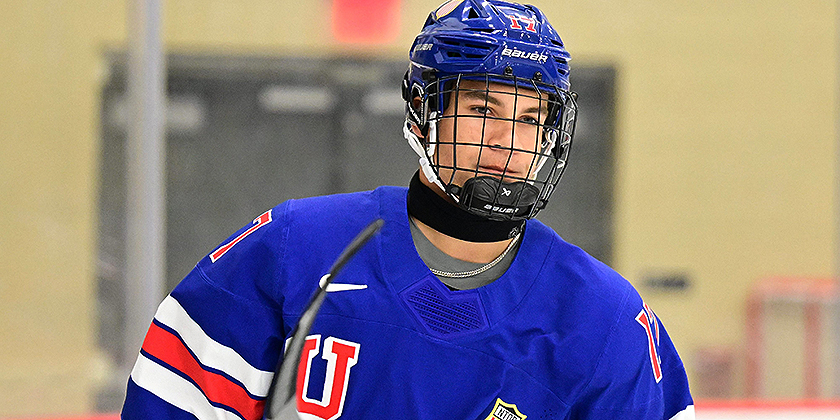
Andrew O’Neill (RW, R, 6’2″, 200, NTDP U18, 02/07/2007, North Dakota)
Case for Andrew O’Neill as an NHL Draft Pick
Prototypical NHL Frame & Versatility
At 6’2″, 200 lbs, O’Neill already possesses NHL-caliber size, which should give him a physical advantage at both the junior and college level.
His ability to play both center and wing makes him a versatile option for a coach looking to adjust lines and matchups.
Physically, he can handle the demands of higher levels, particularly if he continues to add strength and explosiveness while refining his skating.
Defensive Awareness & Role Player Potential
Spends significant time in the defensive zone (6:23 per game), which means – he is either trusted in defensive situations, or has trouble generating defensive zone exits.
Faceoff win percentage (49%) is just under the 50% threshold, meaning he is competent but could still improve to be a true center at the next level.
2.3 takeaways per game – he has an active stick and an ability to disrupt plays in the defensive zone.
Physicality & Engagement
While not overly aggressive, he delivers 0.63 hard hits per game and receives 0.43 hard hits – he can handle physical play without being pushed around.
His ten 50/50 puck battles per game – he is engaged in contested situations.
As he improves his battle-winning percentage (42%), he could become a strong power forward or bottom-six defensive presence.
Competitiveness Against USHL Competition
Against older, more physically developed USHL players, he produced 4 points in 15 games.
His -2 rating in USHL play is much better than his overall -21 – his defensive play improves against higher-end competition, where structure is better.
Case Against Andrew O’Neill as an NHL Draft Pick
Limited Offensive Impact & Poor Shot Generation
5 goals, 12 points in 43 games with the NTDP is low for a forward.
Averages 1.03 shot attempts per game and only 0.8 shots on goal, which is below the rate of draftable forwards.
His 0.3 passes per game leading to a teammate’s shot on goal – a lack of offensive vision and creativity.
Scoring 5 goals in 43 games – he lacks a high-end accuracy, deception, power or finishing ability.
Concerning Plus/Minus & Defensive Struggles
-21 plus/minus (second worst on team) – a red flag regarding his defensive awareness and effectiveness.
Spends more time in the defensive zone (6:23 per game) than the offensive zone (5:54) – his line is often on its heels and chasing the puck / play.
Poor Puck Battle Efficiency & Passing Issues
Wins only 42% of his 50/50 puck battles, which is low for a player of his size and physical tools.
Completes only 78% of his passes, which is well below the 87%+ standard for draftable forwards.
His 0.83 loose puck recoveries after shots per game suggests he does not consistently read or anticipate rebounds.
Final Verdict: Draftable or Not?
Draftable in Later Rounds (6th-7th) If a Team Sees Developmental Upside
Why Draft Him?
Prototypical NHL frame with the ability to play center and wing.
Defensive awareness and ability to be a bottom-six, shutdown forward with continued focused development.
Competes physically and engages in puck battles.
Can be molded into a depth, two-way forward who can kill penalties and take defensive-zone draws.
Why Not Draft Him?
Lacks offensive upside—he is not a play driver, does not generate shots, and does not set up teammates consistently.
Poor puck battle win rate—despite his size, he does not win enough one-on-one battles.
Questionable decision-making—turnovers, giveaways, and low passing efficiency – he struggles when under pressure and having little time and space.
Projection:
NHL Upside: Fourth line checking forward, penalty killer (if he can continue developing his skating, battle-winning ability, and defensive consistency).
Likely Path: CHL and / or NCAA → ECHL/AHL depth player → Possible NHL 4th liner if development goes well.
Draft Range: Late-round flyer, or undrafted free agent signing with AHL development focus after four years of NCAA strength training and continued development.
Conclusion:
Andrew O’Neill has the size and defensive tools to be a depth professional player, but his offensive limitations, inconsistent puck battles, and puck management make him a long-term project. If an NHL team believes they can develop his faceoff ability, defensive structure, and skating, he could be a 4th-line penalty killer. However, his lack of offense and inability to win battles consistently suggest he may struggle to become an NHL regular.
Photo credit: Dan Hickling/Hickling Images
